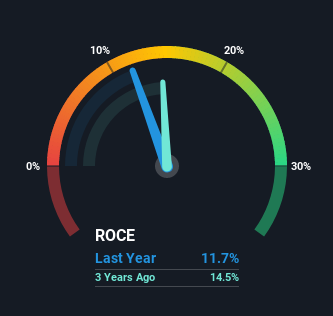- Hong Kong
- /
- Construction
- /
- SEHK:2258
Capital Allocation Trends At Watts International Maritime (HKG:2258) Aren't Ideal

What trends should we look for it we want to identify stocks that can multiply in value over the long term? Firstly, we'll want to see a proven return on capital employed (ROCE) that is increasing, and secondly, an expanding base of capital employed. Ultimately, this demonstrates that it's a business that is reinvesting profits at increasing rates of return. Having said that, from a first glance at Watts International Maritime (HKG:2258) we aren't jumping out of our chairs at how returns are trending, but let's have a deeper look.
Understanding Return On Capital Employed (ROCE)
If you haven't worked with ROCE before, it measures the 'return' (pre-tax profit) a company generates from capital employed in its business. To calculate this metric for Watts International Maritime, this is the formula:
Return on Capital Employed = Earnings Before Interest and Tax (EBIT) ÷ (Total Assets - Current Liabilities)
0.12 = CN¥116m ÷ (CN¥3.3b - CN¥2.3b) (Based on the trailing twelve months to June 2021).
So, Watts International Maritime has an ROCE of 12%. On its own, that's a standard return, however it's much better than the 8.8% generated by the Construction industry.
Check out our latest analysis for Watts International Maritime

Historical performance is a great place to start when researching a stock so above you can see the gauge for Watts International Maritime's ROCE against it's prior returns. If you'd like to look at how Watts International Maritime has performed in the past in other metrics, you can view this free graph of past earnings, revenue and cash flow.
So How Is Watts International Maritime's ROCE Trending?
On the surface, the trend of ROCE at Watts International Maritime doesn't inspire confidence. To be more specific, ROCE has fallen from 20% over the last five years. Although, given both revenue and the amount of assets employed in the business have increased, it could suggest the company is investing in growth, and the extra capital has led to a short-term reduction in ROCE. If these investments prove successful, this can bode very well for long term stock performance.
On a side note, Watts International Maritime's current liabilities are still rather high at 70% of total assets. This can bring about some risks because the company is basically operating with a rather large reliance on its suppliers or other sorts of short-term creditors. While it's not necessarily a bad thing, it can be beneficial if this ratio is lower.
The Bottom Line
Even though returns on capital have fallen in the short term, we find it promising that revenue and capital employed have both increased for Watts International Maritime. Despite these promising trends, the stock has collapsed 81% over the last three years, so there could be other factors hurting the company's prospects. Therefore, we'd suggest researching the stock further to uncover more about the business.
On a final note, we found 5 warning signs for Watts International Maritime (2 are significant) you should be aware of.
While Watts International Maritime may not currently earn the highest returns, we've compiled a list of companies that currently earn more than 25% return on equity. Check out this free list here.
Valuation is complex, but we're here to simplify it.
Discover if Watts International Maritime might be undervalued or overvalued with our detailed analysis, featuring fair value estimates, potential risks, dividends, insider trades, and its financial condition.
Access Free AnalysisHave feedback on this article? Concerned about the content? Get in touch with us directly. Alternatively, email editorial-team (at) simplywallst.com.
This article by Simply Wall St is general in nature. We provide commentary based on historical data and analyst forecasts only using an unbiased methodology and our articles are not intended to be financial advice. It does not constitute a recommendation to buy or sell any stock, and does not take account of your objectives, or your financial situation. We aim to bring you long-term focused analysis driven by fundamental data. Note that our analysis may not factor in the latest price-sensitive company announcements or qualitative material. Simply Wall St has no position in any stocks mentioned.
About SEHK:2258
Watts International Maritime
An investment holding company, operates as a port, waterway, and marine and municipal public engineering services provider in the People's Republic of China.
Mediocre balance sheet and slightly overvalued.
Market Insights
Community Narratives




